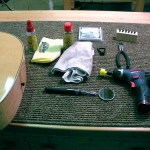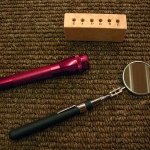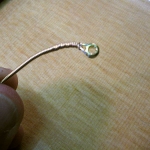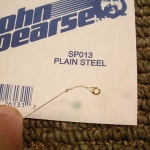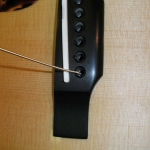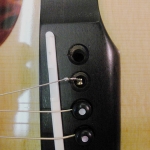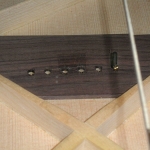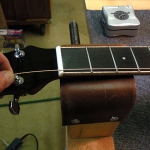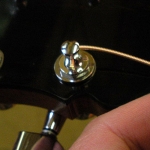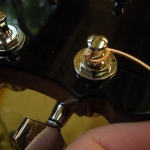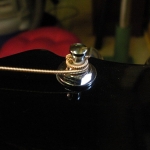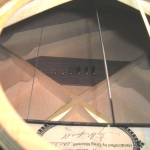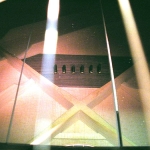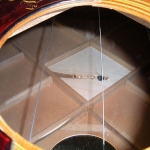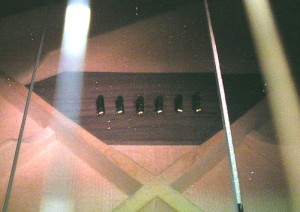 When I went to lutherie school I discovered that, like many guitarists, I was stringing my guitars incorrectly. And judging from the inspections that I give to all the guitars that come into my shop, this is a very common problem. I can hear some players saying, “You’ve got to be kidding! I’ve been stringing up guitars since I was a teenager and I have managed to do just fine, thanks.” I held this same attitude… until I learned what incorrect stringing can do to a guitar’s bridge plate. This is the small piece of Rosewood or Maple inside of the guitar and located directly under the bridge. The ball end of the strings pull into place against this plate, preventing them from tearing through the soft spruce top when under tension. It is very easy to string a guitar correctly, and frankly there is no excuse not to. Failure to do so will, over time, wear the bridge plate holes to the point that an expensive and completely avoidable repair must be made.
When I went to lutherie school I discovered that, like many guitarists, I was stringing my guitars incorrectly. And judging from the inspections that I give to all the guitars that come into my shop, this is a very common problem. I can hear some players saying, “You’ve got to be kidding! I’ve been stringing up guitars since I was a teenager and I have managed to do just fine, thanks.” I held this same attitude… until I learned what incorrect stringing can do to a guitar’s bridge plate. This is the small piece of Rosewood or Maple inside of the guitar and located directly under the bridge. The ball end of the strings pull into place against this plate, preventing them from tearing through the soft spruce top when under tension. It is very easy to string a guitar correctly, and frankly there is no excuse not to. Failure to do so will, over time, wear the bridge plate holes to the point that an expensive and completely avoidable repair must be made.
The most important element of stringing correctly is aligning the ball ends of the string parallel with the body of the guitar, and seating them firmly against the bridge plate before you bring them to tension. It is poor technique to use the bridge pins to push the ball ends into the holes and then pull up on the string to seat the ball. Doing so literally uses the winding on the string like a miniature saw, ripping a groove into the plate that gets worse each time this is repeated. And allowing the ball end to sit perpendicular to the guitar body also eats away at the plate. When you see a guitar with the windings on the string ends protruding through the top of the bridge to the point they are nearing the saddle, you can know that the guitar’s bridge plate has been worn and needs a repair to save more damage. The good news is that a bridge plate will stay as good as new for decades if the simple steps in the photo gallery below are followed.
For those who are interested, there is a video that goes into detail showing how to install strings correctly. This video is part of my online Setup and Repair Series, available through Robbie Obrien’s Lutherie Academy. Follow this link to access my class on installing strings, as well as many other topics.
Also, check out this quick video showing the fast and easy way to install your strings on the peghead tuning posts:
